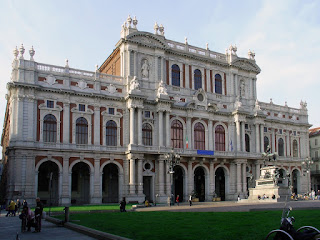1861 vote preceded proclamation of new Kingdom
 |
| Count Camillo Benso di Cavour was named Italy's first prime minister |
The vote was a major milestone in the Risorgimento - the movement to bring together the different states of the region as one country - enabling there to be a parliament in place the following month and for deputies to declare Victor Emmanuel II of Sardinia as the first King of Italy in March.
The first parliament convened in Turin as Rome remained under the control of the Papal States until it was captured by the Italian army in 1870.
The body comprised 443 deputies representing 59 provinces. Some provinces, such as Benevento, near Naples, elected just one deputy, whereas the major cities elected many more. Turin, for example, chose 19 deputies, Milan and Naples 18 each.
The eligibility rules were so specific that of a population of around 22 million, only 418,696 people were entitled to vote.
In line with the procedures set down in the electoral laws of the Kingdom of Sardinia, only men could vote - women were not fully enfranchised in Italy until 1945 - and only men aged 25 and above who were literate and paid a certain amount of taxes, in most cases at least 40 lire per year.
 |
| The new parliament proclaimed Victor Emmanuel II as king |
The election was in two stages, the voting on 27 January being followed by, where necessary, a second ballot a week later on 3 February. A second vote took place only when no candidate received more than 50 per cent of the vote or the equivalent of one-third of the registered voters in the constituency.
Of the 418,696 who could have voted, only 239,583 actually did and 10,000 votes were declared invalid, which meant that the first government was decided by barely one percent of the population. The turnout was not helped by the Pope demanding that Catholics take no part.In the absence of political parties as would be recognised today, the candidates representing blocs according to their values.
The group known as the Destra Storico - the Historical Right - comprised conservatives and monarchists and was led by Camillo Benso, Count of Cavour, the former prime minister of Sardinia, an experienced statesman who had been an important figure in the drive to unification.
Against the Right, the Sinistra Storica - the Historical Left - was made up of liberals and centrists, led by Urbano Rattazzi.
The election was also contested by the Historical Far Left - also known as the Partito d’Azione - the radical grouping led by the revolutionary Giuseppe Mazzini and with which Giuseppe Garibaldi also alligned himself.
Mazzini and Garibaldi were also key figures in the Risorgimento, but in a different way from Cavour. Mazzini, often described as the movement's ideological inspiration, had been behind many uprisings from the 1830s onwards as Italians rebelled against the rule of oppressive foreign powers and Garibaldi led the military campaign to unite the peninsula. Mazzini, in particular, wanted the new country to be a republic.
 |
| Mazzini's party was not widely supported |
Cavour was duly elected prime minister and parliament convened for the first time on 4 March in Turin, where 13 days later they proclaimed the new Kingdom of Italy and confirmed Victor Emmanuel as the first monarch.
As King of Sardinia, Victor Emmanuel had appointed Cavour as prime minister of Sardinia-Piedmont. The new king’s insistence on ruling as Victor Emmanuel II - as he had called himself in Sardinia in respect of his ancestor Victor Emmanuel I - upset some factions, who felt it implied that Italy was actually ruled by the House of Savoy.
Cavour’s term in office proved to be brief, in the event, as the stress of the job, dominated by the question of how to bring Rome and Venice into the new kingdom to make it fully unified, took its toll. He succumbed to malaria and died after only 75 days in office, at the age of just 50.
 |
| Palazzo Carignano, birthplace of the King, where Italy's first parliament met in 1861 |
The first Italian parliament met in Palazzo Carignano in Turin, the house in which Victor Emmanuel II was born. Designed by the Piedmontese architect Guarino Guarini, the Baroque palace in Via Accademia delle Scienze dates back to 1679. It now houses the National Museum of the Risorgimento, the biggest of 23 museums in Italy devoted to the movement. The building has a lavish interior with many frescoes, some by Stefano Legnani, a painter of the Baroque period who was known in his native Milan as Legnanino.
 |
| The medieval Grinzane Castle was Cavour's home for 31 years until his death |
Camillo Benso di Cavour, Italy’s first prime minister, hailed from a background in Turin nobility. He was the second son of the fourth Marquess of Cavour and for a large part of his life lived at the 13th century castle of Grinzane Cavour near Turin, which is now a UNESCO World Heritage site. Born in 1810, Cavour lived there from 1830 until his death in 1861. During his stays there he restored the building and improved the cultivation of the vines in the area. Today, the castle has rooms dedicated to Cavour as well as the Cavour Regional Enoteca, which showcases the best wines produced in the region.
More reading:
How Giuseppe Mazzini was the ideological inspiration for the Risorgimento
Garibaldi's Expedition of the Thousand
How the capture of Rome completed Italian unification
Also on this day:
98: Trajan becomes Emperor of Rome
1881: The birth of mobster Frank Nitti
1901: The death of composer Giuseppe Verdi
1962: The birth of composer and film director Roberto Paci Dalò
_________________________________________________________
Find out more:
A Concise History of Italy, by Christopher Duggan. Buy from
(Picture credit: Grinzane Castle by Sbisolo via Wikimedia Commons)











